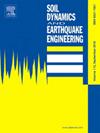Transverse seismic performance of small and medium-span simply supported bridges with buffered block seismic damping systems
IF 4.2
2区 工程技术
Q1 ENGINEERING, GEOLOGICAL
引用次数: 0
Abstract
To improve the transverse seismic performance of small and medium-span simply supported bridges and ensure their post-earthquake traffic capacity, this paper proposes the Buffered Block Seismic Damping System (BBSDS). The BBSDS is designed to dissipate energy and limit displacements through a slip-and-deformation mechanism. The mechanical properties of the BBSDS are validated through theoretical analysis and numerical simulations. Additionally, a simplified mechanical model is developed. Nonlinear analysis models of simply supported bridges are established for four working conditions: without shear keys, with concrete shear keys, with steel shear keys, and with BBSDS. The base shear, base moment, relative displacement between the pier and girder, residual displacement, and bearing displacement are compared. The results show that a simply supported bridge with BBSDS effectively limits the displacement of the girder without significantly increasing the base response of the pier. Notably, the BBSDS also reduces the residual displacement and bearing displacement, thereby mitigating bearing failure. Parametric analyses were conducted on the slip stiffness, limit stiffness, and initial gap of the BBSDS. The results indicated that an increase in slip stiffness or limit stiffness effectively reduced the residual displacement; however, it may concurrently elevate the base response of the pier. The increase in the initial gap reduced the base response of the pier, but increased the relative displacement between the pier and beam, as well as the residual displacement. The recommended range of design parameters for the BBSDS is provided.
采用缓冲砌块减震系统的中小跨简支桥横向抗震性能研究
为了提高中小跨简支桥的横向抗震性能,保证其震后通行能力,本文提出了缓冲块体抗震阻尼系统(BBSDS)。BBSDS旨在通过滑移和变形机制来耗散能量并限制位移。通过理论分析和数值模拟验证了BBSDS的力学性能。此外,还建立了一个简化的力学模型。建立了无剪切键、混凝土剪切键、钢剪切键和BBSDS四种工况下简支桥的非线性分析模型。对基础剪力、基础弯矩、墩梁相对位移、残余位移、支座位移进行了比较。结果表明:在不显著增加桥墩基底响应的情况下,采用BBSDS的简支桥有效地限制了主梁的位移;值得注意的是,BBSDS还减少了残余位移和轴承位移,从而减轻了轴承的破坏。对滑移刚度、极限刚度和初始间隙进行了参数化分析。结果表明,增加滑移刚度或极限刚度可有效降低残余位移;然而,它可能同时提高桥墩的基础响应。初始间隙的增大减小了桥墩的基底响应,但增加了桥墩与梁之间的相对位移以及剩余位移。提供了BBSDS的推荐设计参数范围。
本文章由计算机程序翻译,如有差异,请以英文原文为准。
求助全文
约1分钟内获得全文
求助全文
来源期刊

Soil Dynamics and Earthquake Engineering
工程技术-地球科学综合
CiteScore
7.50
自引率
15.00%
发文量
446
审稿时长
8 months
期刊介绍:
The journal aims to encourage and enhance the role of mechanics and other disciplines as they relate to earthquake engineering by providing opportunities for the publication of the work of applied mathematicians, engineers and other applied scientists involved in solving problems closely related to the field of earthquake engineering and geotechnical earthquake engineering.
Emphasis is placed on new concepts and techniques, but case histories will also be published if they enhance the presentation and understanding of new technical concepts.
 求助内容:
求助内容: 应助结果提醒方式:
应助结果提醒方式:


